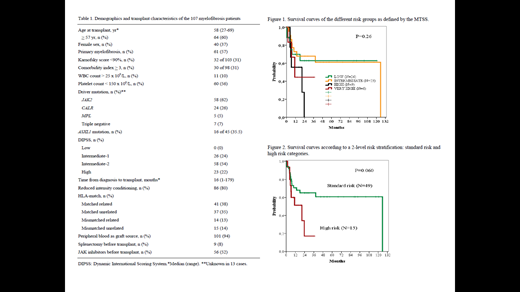Introduction: Allogeneic hematopoietic cell transplantation (allo-HCT) constitutes the only curative treatment for myelofibrosis (MF), but its associated toxicity remains high. Prognostic risk models are widely used in clinical practice to select those MF patients who are more likely to benefit from transplantation. Recently, a new prognostic model, the Myelofibrosis Transplant Scoring System (MTSS), has been developed to predict the outcome of MF patients undergoing allo-HCT (Gagelmann N et al, Blood 2019). We aimed to evaluate the performance of such model in an independent series of patients.
Methods: This is a retrospective study that included all adult patients who underwent first allo-HCT for MF between January 2005 and May 2019 in 8 Spanish hospitals. Patients transplanted after leukemic transformation were excluded. Survival probability from the time of HCT was estimated by the method of Kaplan-Meier and compared by the log-rank test. Each parameter of the MTSS was tested for its potential association with survival in univariate analysis. Cumulative incidence functions were used to estimate incidence of Graft-versus-Host-Disease (GVHD), Relapse Incidence (RI), and Non-Relapse Mortality (NRM) within a competing risk setting. Statistical analyses were performed with SPSS 19 (SPSS Inc./IBM, Armonk, NY) and R.
Results: Demographics and transplant characteristics of the overall series of 107 MF patients are shown in Table 1. After a median follow-up from allo-HCT of 5.3 years, 49 patients (46%) had died. The survival probability at 1, 3, and 5-years was 64.5%, 52%, and 50%, respectively. Transplantation outcome improved over the years. Thus, the survival probability at 3-years was 35% (95% CI: 12-58), 50% (95% CI: 33-67), and 65% (95% CI: 50-80) during the time periods 2005-2009 (n=17), 2010-2014 (n=34), and 2015-2019 (n=56), respectively (P=0.038). The cumulative incidence of grade II-IV acute GVHD at day 100 was 45%. The cumulative incidence of relapse at 1, 3, and 5-years was 16%, 19.5%, and 19.5%, respectively. NRM probability at 1, 3, and 5-years was 24%, 29%, and 31%, respectively. In univariate analysis, the only parameter included in the MTSS that was significantly associated with survival was the Karnofsky performance status < 90% (HR: 1.9, 95% CI: 1.1-3.4; P=0.031). Neither age > 57 years (P=0.68), platelets <150 x 109/L (P=0.79), leukocytes >25 x 109/L (P=0.38), ASXL1 mutations (P=0.34), non-CALR/MPL driver mutation (P=0.57) nor HLA-mismatched unrelated donor (P=0.22) correlated with survival. Among other classical risk factors for transplant outcome, only a comorbidity index >= 3 was significantly associated with shorter survival (HR: 2.1, 95% CI: 1.1-4; P=0.017). A total of 64 cases had all required clinical and molecular data to calculate the MTSS. Figure 1 shows the survival curves of the different risk groups as defined by the MTSS. As can be seen, the prognostic model was not able to discriminate four risk groups. We then pooled together patients assigned to the low (n=26) and intermediate risk (n=23) groups, and those within the high (n=9) and very high risk (n=6) groups. On this basis, two-categories could be identified: standard risk (n=49 [77% of patients]) and high risk (n=15 [23%]). The 3-year overall survival was 65% (95% CI: 51-79) in the standard risk and 17% (95% CI: 0-46) in the high risk categories (P=0.060)(Figure 2).
Conclusions: the MTSS did not discriminate four different risk categories in our series. Both, the limited number of cases and the differences in patients and transplant characteristics in our series as compared to those of the original MTSS cohort might account for this finding. Nevertheless, the MTSS was able to identify a subset of patients with a very poor prognosis after transplantation. Such information could be useful to assist on transplant decision-making.
Sanchez-Guijo:Novartis: Consultancy, Honoraria, Research Funding; BMS: Consultancy, Honoraria; Incyte: Consultancy, Honoraria; Pfizer: Consultancy, Honoraria; Gilead: Consultancy, Honoraria; Amgen: Honoraria; Roche: Honoraria. Hernandez Boluda:Incyte: Other: Travel expenses paid.
Author notes
Asterisk with author names denotes non-ASH members.


This feature is available to Subscribers Only
Sign In or Create an Account Close Modal